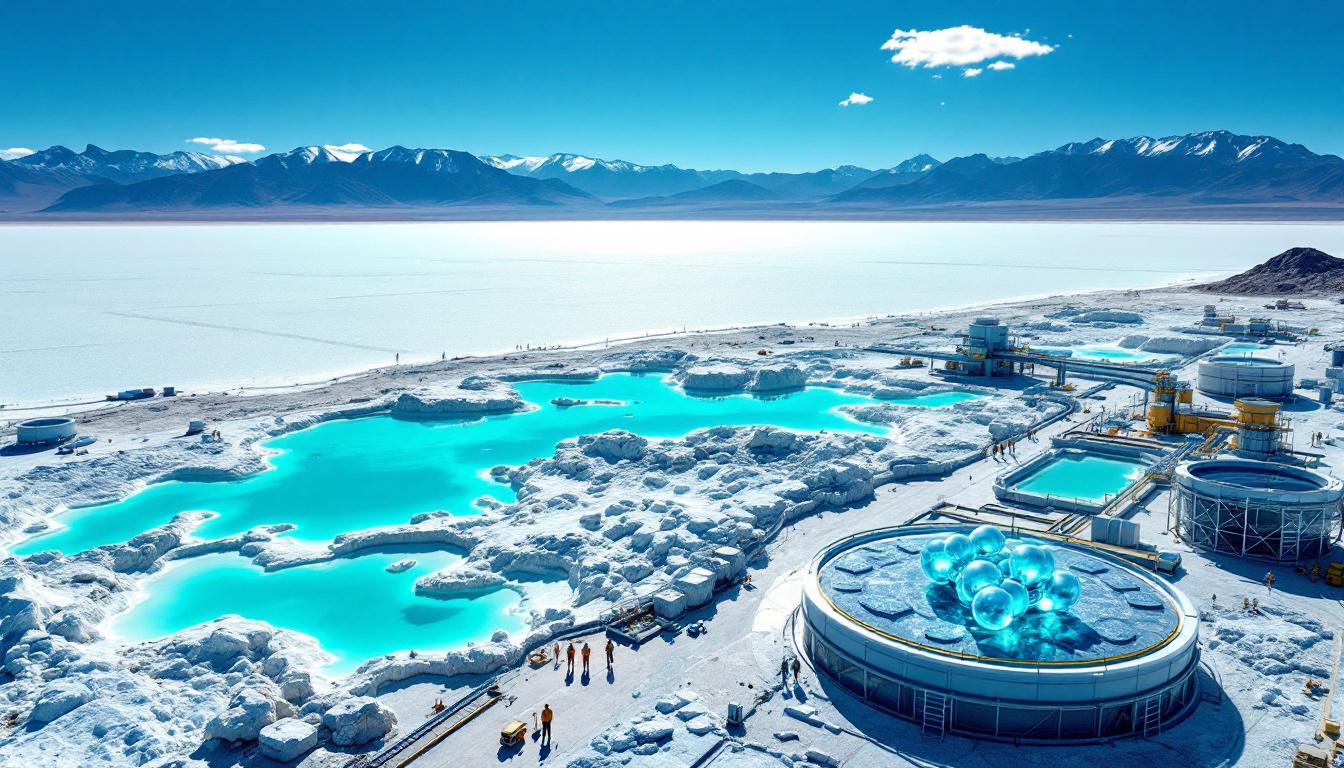How Does Codelco's Profitability Impact Chile's Presidential Election?
Chile's state-owned copper mining giant Codelco stands at the crossroads of politics and economics as the country approaches its presidential election. As a cornerstone of Chile's economy, Codelco's financial health has become a central campaign issue, with candidates offering contrasting visions for its future management and structure.
The mining behemoth historically contributes between 10-20% of government revenue, making its financial performance directly relevant to Chile's fiscal stability. With President Gabriel Boric's administration holding just 22% approval (according to Centro de Estudios Publicos), candidates are leveraging Codelco's challenges to position themselves as economic problem-solvers.
"The tax burden that state coffers capture is a very high proportion of total profits. That's what needs to change," states Alvaro Garcia, economic spokesperson for presidential hopeful Carolina Toha, highlighting how Codelco's financial structure has become a campaign lightning rod.
The election outcomes will determine whether Codelco continues its current profit-sharing arrangement with the government mining intervention or undergoes substantial reform, potentially reshaping both the company's trajectory and Chile's economic landscape for years to come.
What Financial Challenges Is Codelco Currently Facing?
Mounting Debt and Production Concerns
Codelco's financial situation has deteriorated to alarming levels, creating urgency for structural reform. The company's debt-to-earnings ratio stands at 5.9 times earnings before items—making it the most leveraged major copper producer globally according to Bloomberg data.
This precarious financial position stems from several converging factors:
- Production has plummeted to 25-year lows through 2023, severely impacting revenue generation
- Debt has ballooned to over $20 billion, with research center Cesco warning it could reach a staggering $30 billion by decade's end if current trends continue
- Debt payment obligations are mounting, with approximately $940 million due in 2025 and $1 billion in 2026
- Credit rating downgrades in 2023 have increased borrowing costs, further straining finances
The combination of falling production and rising debt has created what mining analysts describe as a potential "death spiral" without intervention.
Revenue Distribution Constraints
The current financial structure severely limits Codelco's ability to reinvest in its operations:
- 70% of profits must be transferred directly to government coffers
- An additional 10% of sales revenue must be contributed regardless of profitability
- These mandatory transfers leave Codelco with insufficient capital to fund critical infrastructure improvements
- Operational improvements and technological upgrades are consistently delayed due to capital constraints
This arrangement, while beneficial for short-term government spending, has created long-term structural problems for Chile's mining crown jewel.
Capital Investment Requirements
Despite its financial limitations, Codelco faces urgent investment needs that cannot be indefinitely postponed:
- Over $4 billion in annual capital expenditures are planned through 2030 to maintain operational viability
- Decades of underinvestment have led to deteriorating ore quality across mining operations
- More rock must be processed to extract the same amount of copper, driving up operational costs
- New lithium business ventures require substantial upfront capital yet offer diversification opportunities
The company's ability to secure this investment will determine whether Chile maintains its position as the world's leading copper price insights or faces continued production declines.
How Would Carolina Toha's Presidency Affect Codelco?
Proposed Financial Restructuring
Presidential candidate Carolina Toha has made Codelco's financial rehabilitation a cornerstone of her economic platform. According to her economic spokesperson Alvaro Garcia, a former Economy and Energy Minister, a Toha administration would implement significant changes to Codelco's financial structure:
- Allow the company to retain a substantially larger portion of its profits for reinvestment
- Reduce reliance on debt markets for funding essential capital projects
- Enable self-funding of critical mine modernization efforts through improved cash flow retention
- Support expansion into lithium operations as part of a broader diversification strategy
"We need to change the way Codelco contributes to the treasury," Garcia emphasized in a recent interview. "The current approach is unsustainable and threatens national interests."
Economic Growth Strategy
Rather than viewing reduced government revenue from Codelco as a fiscal sacrifice, Toha's team presents it as an investment in future economic growth. Her broader economic plan would compensate for reduced immediate revenue through:
- Leveraging renewable energy development to attract foreign investment
- Expanding rare earths and mineral extraction beyond traditional copper mining
- Streamlining project approvals to accelerate new development timelines
- Reducing corporate tax rates from 27% to 24%, building on a reform previously shelved by Finance Minister Mario Marcel
- Investing in infrastructure improvements like modernized ports to enhance export capabilities
Garcia notes that "[We will] spur the economy by leveraging renewable energy, rare earths, and energy transition minerals," positioning Codelco's reform as part of a comprehensive economic development strategy rather than an isolated policy.
What Are Other Candidates Proposing for Codelco?
Right-Wing Approaches
Conservative candidates have proposed more dramatic changes to Codelco's structure, representing a philosophical divide in how Chile should manage its most valuable state asset:
- Johannes Kaiser's team has suggested incorporating private capital into Codelco through partial privatization
- Several right-wing candidates advocate selling non-core assets to reduce debt and improve financial ratios
- Market-oriented approaches emphasize operational efficiency over state revenue generation
- Reduced government control is presented as necessary for competitiveness in global markets
These proposals reflect a fundamental difference in economic philosophy compared to left-wing candidates, positioning the election as a referendum on state ownership in strategic industries.
Political Landscape
The election features a highly fragmented field with diverse approaches to Codelco's future:
- Evelyn Matthei leads right-wing candidates with positions increasingly aligned with hard-right competitors
- Jose Antonio Kast represents the traditional conservative approach with strong emphasis on security issues
- Left-wing primary contenders include Jeannette Jara and Gonzalo Winter alongside Toha
- Current polling shows Toha in third place with 12% support according to the May 12 Cadem poll
According to BTG Pactual analyst Cesar Perez-Novoa, "Not allowing [Codelco] to retain funds means much more debt will be incurred," highlighting how financial experts view the current arrangement as unsustainable regardless of political affiliation.
How Might the Election Impact Chile's Mining Sector?
Investment Climate Considerations
The election outcome will significantly influence Chile's attractiveness to mining investors at a time when global competition for mining capital is intensifying:
- Tax reform proposals vary widely between candidates, creating uncertainty for long-term investment planning
- Toha proposes reducing corporate tax rates from 27% to potentially 24% to stimulate economic activity
- Regulatory streamlining is a priority across the political spectrum, though implementation approaches differ
- Security concerns remain paramount for investors with 60% of Chilean voters citing crime as their top concern in recent polling
Mining executives are closely monitoring the election, as policy stability is crucial for the decade-long investment horizons typical in copper investment trends.
Copper Market Implications
As the world's largest copper producer, changes to Codelco have global implications that extend beyond Chile's borders:
- Production recovery is essential to meet growing global demand driven by electrification and renewable energy
- Investment decisions worth billions are being delayed by electoral uncertainty
- Potential partnerships with international mining companies hang in the balance
- Environmental and community considerations increasingly influence development timelines and approval processes
The election's outcome could determine whether Chile maintains its global copper leadership or continues to lose market share to competitors like Peru and the Democratic Republic of Congo.
What Is the Election Timeline and Process?
Key Electoral Dates
Chile's presidential election will unfold through multiple stages in 2025:
- June 29, 2025: Primary vote for leftist presidential candidates
- November 16, 2025: First-round presidential election
- December 14, 2025: Potential run-off election if no candidate secures a majority
This extended timeline means mining policy uncertainty will persist through much of 2025, potentially delaying major investment decisions.
Voter Priorities
Several key issues are driving voter preferences beyond mining policy:
- Crime and security concerns rank as top priorities for 60% of respondents according to recent Cadem polling
- Clandestine migration remains a significant concern particularly in northern mining regions
- Economic growth and investment climate are gaining importance as inflation moderates
- Continuation of current policies faces headwinds with the Boric administration's 22% approval rating
These voter priorities will shape how candidates position their Codelco policies within broader economic and security frameworks.
What Are the Potential Outcomes for Codelco?
Scenario Analysis
The election presents several potential futures for Codelco, each with distinct implications for the company and Chile:
| Scenario | Profit Retention | Debt Trajectory | Investment Capacity | Government Revenue |
|---|---|---|---|---|
| Toha Victory | Increased from 30% | Stabilizing | Enhanced self-funding | Short-term decrease |
| Right-Wing Victory | Variable | Potential reduction through asset sales | Dependent on private capital | Potential privatization revenue |
| Status Quo | 30% | Continued increase toward $30B | Limited by profit transfers | Maintained short-term |
Mining analysts note that maintaining the status quo poses significant long-term risks to Chile's copper production capabilities and global copper supply.
Long-Term Considerations
Beyond immediate financial impacts, the election will shape several fundamental aspects of Chile's mining industry:
- Copper industry competitiveness in an increasingly challenging global market
- National economic development strategy and diversification beyond traditional mining
- Public-private partnership models for capital-intensive projects
- Resource nationalism policies balancing sovereignty with investment needs
These considerations extend beyond a single electoral cycle, potentially setting Chile's resource development trajectory for decades.
How Does This Election Fit into Chile's Mining History?
Historical Context
Chile's relationship with its mining sector has evolved significantly over the past century:
- Codelco was formed through nationalization of foreign-owned mines in the 1970s under Salvador Allende
- The company has historically served as a primary revenue source for government programs across administrations
- Previous administrations have debated appropriate balance between reinvestment and dividends
- Global copper price cycles have influenced political approaches to the industry, with boom periods often reducing pressure for reform
This historical context explains why changes to Codelco's structure remain politically sensitive despite clear financial challenges.
Regional Comparisons
Chile's approach to state-owned mining differs from regional neighbors, providing contrasting models:
- Peru has pursued more private-sector development with state maintaining regulatory role
- Bolivia maintains stricter state control of resources but struggles with production efficiency
- Brazil's Vale represents a mixed ownership model balancing public and private interests
- Mexico's mining sector features limited state ownership focusing instead on royalty frameworks
These regional comparisons offer valuable lessons as Chile considers Codelco's future structure and governance.
FAQ: Codelco and Chile's Presidential Election
How significant is Codelco to Chile's economy?
Codelco remains Chile's largest company and a crucial source of export revenue and government funding. The company historically contributes between 10-20% of government revenue depending on copper prices, making its financial health directly relevant to national fiscal stability.
Would privatization be considered under any candidates?
While full privatization isn't explicitly proposed by major candidates, right-wing contenders have suggested partial private capital incorporation and non-core asset sales. The state's majority ownership of Codelco remains politically sensitive across the spectrum, though the degree of private sector involvement is actively debated.
How would Toha's policies affect copper production?
By allowing Codelco to retain more profits for reinvestment, production could potentially recover from recent lows through modernization of aging infrastructure and optimization of existing operations. However, results would take years to materialize given the scale of required improvements and long development timelines typical in the mining industry.
What impact would these changes have on global copper markets?
Improved financial health for Codelco could eventually increase global copper supply, potentially moderating prices in the medium term as production recovers from recent lows. Given copper's critical role in electrification and renewable energy, Codelco's production trajectory has significant implications for global energy transition timelines and materials availability.
Disclaimer: This analysis contains forecasts and speculation about potential electoral outcomes and their impacts on Codelco and global copper markets. Readers should consider multiple scenarios and consult diverse sources when making investment or policy decisions related to the Chilean mining sector.
Want to Stay Ahead of Major Mineral Discoveries?
Discovery Alert's proprietary Discovery IQ model instantly notifies subscribers of significant ASX mineral discoveries, helping you identify actionable opportunities before the market. Visit the Discovery Alert discoveries page to see how major mineral discoveries have historically generated substantial returns for early investors.




